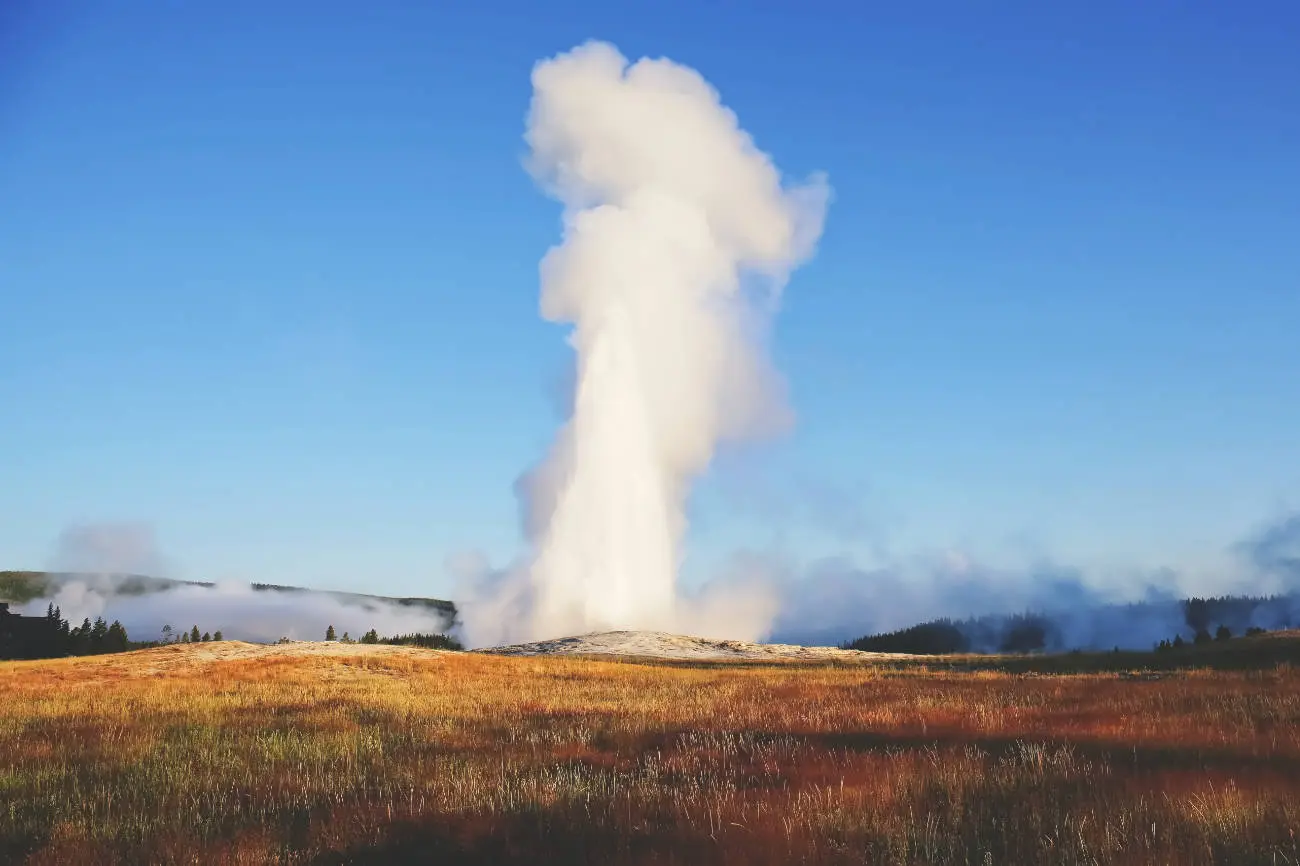An In-Depth Look at the First Geothermal Power Plant in US History
The first geothermal power plant in the US marked a milestone in renewable energy history. Learn about its inception and impact with an exploration of its significance.
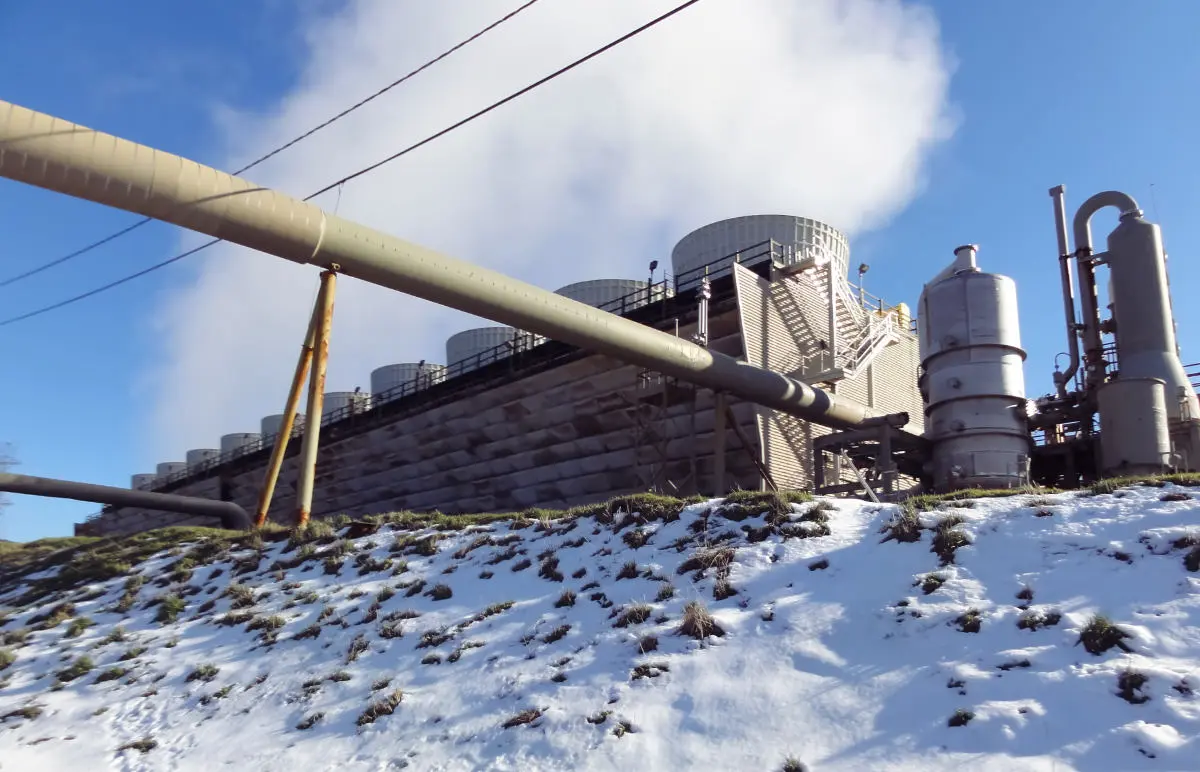
The quest for renewable energy sources has always been a critical endeavor, but the journey took a significant turn with the commissioning of the first geothermal power plant in the US.
Nestled in the Mayacamas Mountains in Sonoma County, California, The Geysers is the pioneering geothermal power producer in the United States.
This in-depth exploration of the first geothermal power plant in the US not only illuminates its historical significance but also underscores its impact on the renewable energy landscape.
The Dawn of Geothermal Power in the United States
Geothermal energy's journey in the United States embarked on a historic path in 1960 with the commissioning of The Geysers, marking its debut as the country's inaugural geothermal power plant. This pioneering endeavor was led by the Pacific Gas and Electric Company, which ventured into what was then a relatively unknown domain of energy production.
In 1950, the Pacific Gas and Electric Company (PG&E) conducted a number of investigations and trials in the area. The first commercial geothermal well was drilled in 1955, and the first commercial geothermal power plant, The Geysers in California, was operational in September 1960. Engineers have extensively expanded the site and its capacity since.
The location for this groundbreaking project was selected due to its pronounced geothermal activity, notably its abundant natural steam fields. These fields were not a new discovery, having been recognized and utilized for various purposes by Native American tribes long before their integration into the energy sector. They used the natural steam for heating and medicinal purposes, acknowledging the land's inherent power.
The choice of The Geysers as the site for the first geothermal power plant was predicated on this longstanding natural phenomenon, leveraging the Earth's latent energy to be used for power generation. The realization of this facility was timely, coinciding with an era increasingly attuned to the limitations and environmental drawbacks of traditional fossil fuel-based energy sources. The burgeoning environmental movement and growing concerns over energy security catalyzed a surge in interest in renewable energy forms that could offer both sustainability and reduced ecological impact.
Understanding Geothermal Energy: How Does It Work?
Geothermal energy taps into the immense heat stored beneath the Earth's crust, a vast, clean, and virtually inexhaustible source of power. Harnessing this energy for human use begins by identifying and drilling into underground reservoirs containing hot water and steam. These geothermal resources can come from shallow ground, hot water, and rock several miles deep or even further down to where the molten rock is found.
In locations such as The Geysers, where dry steam flows naturally from the Earth, this steam can be directly utilized to rotate turbines connected to generators, thereby producing electricity. The turbines transform the kinetic energy of the steam into mechanical energy, which the generators then convert into electricity. In other settings where hot water is more prevalent than steam, the water can either be flashed into steam under lower pressure or passed through a heat exchanger, where its heat is transferred to a secondary liquid with a lower boiling point, vaporizing and driving the turbines.
This method of generating power is renowned for its low emission footprint, as it significantly reduces the reliance on fossil fuels and minimizes the overall environmental impact. The process efficiently leverages the Earth's internal heat without depleting the resource, making geothermal energy a standout among renewable energy sources.
About the Geysers - the First US Geothermal Power Plant
The Geysers is the world's largest complex of geothermal power plants located in Northern California in the Mayacamas Mountains. It is a network of 18 power plants that harness the natural geothermal energy from underground steam reservoirs to generate electricity. The Geysers was first developed in the early 1960s and has since become a significant source of renewable energy for the region.
The geothermal power plants at The Geysers use steam from the Earth's core to drive turbines and produce electricity. The steam is extracted through wells drilled deep into the reservoirs, where the hot water is converted to steam and then used to power the turbines. The Geysers has a total capacity of 725 megawatts, providing enough electricity to power hundreds of thousands of homes. In 2019, The Geysers produced 20% of the renewable energy in California.
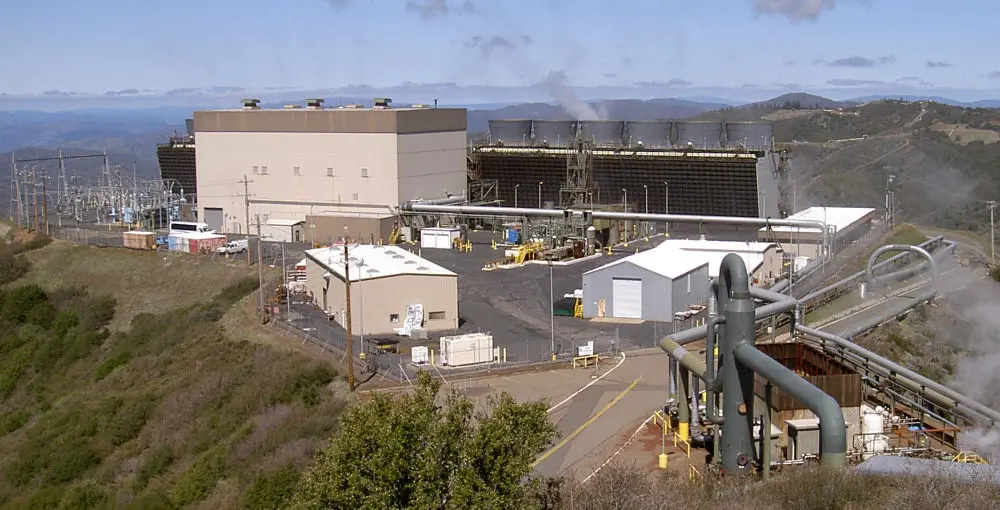
Three things are required to generate geothermal energy: near-surface magma, permeable or broken rock, and fluids that can pass through the heated rock. The rock intrusion at The Geysers dates back over a million years, yet it is only 0.6 miles (1 kilometer) below the surface and relatively easy to access.
One of the key benefits of geothermal power is that it doesn't emit greenhouse gasses and its renewable nature, making it a clean energy source with minimal environmental impact. The Geysers also help reduce dependence on fossil fuels and provide a reliable source of electricity for the local community.
The Construction and Design of The Geysers
The Geysers consist of multiple geothermal power plants operated by various companies. These power plants collectively have dozens of individual units. Each unit typically includes geothermal wells, steam gathering systems, turbines, and generators. These units vary in size and capacity, with some capable of generating hundreds of megawatts of electricity. Overall, The Geysers is a complex of interconnected geothermal power facilities, contributing significantly to California's renewable energy production.
The construction of The Geysers was a formidable challenge that called for pioneering engineering strategies. The original facility, designated as Unit 1, was constructed with the capacity to generate 11 megawatts of power, sufficient to supply electricity to around 11,000 households.
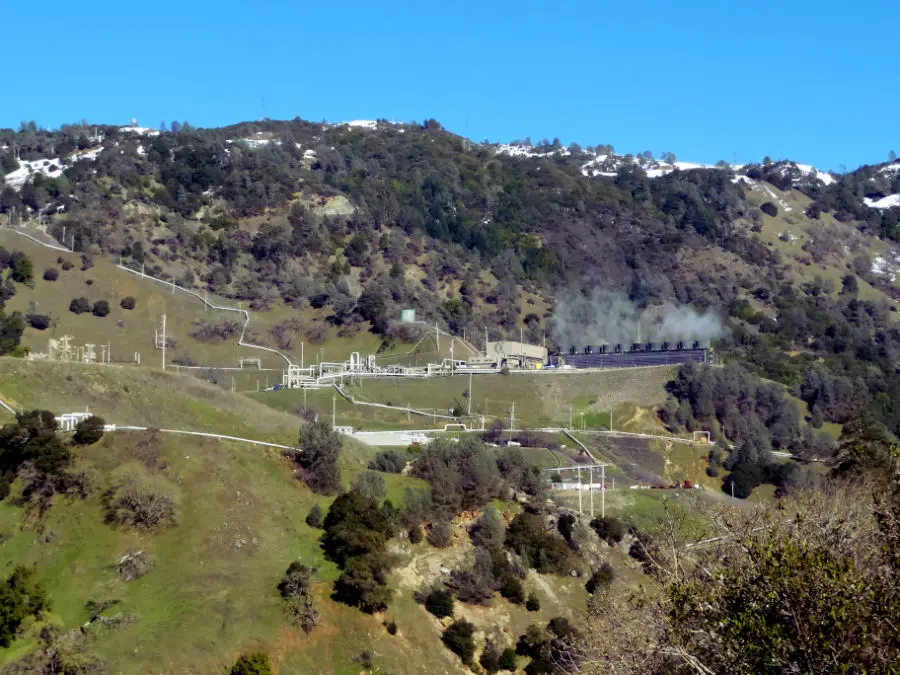
Key to its development was drilling deep wells designed to access the vast natural steam reservoirs beneath the surface. An intricate network of piping was laid out to facilitate the efficient transport of steam from these wells to the power-generating units.
The heart of the operation involved assembling turbines and generators, the critical components responsible for converting the kinetic energy of steam into usable electricity. The successful commissioning of Unit 1 marked a significant technological triumph, setting the stage for the expansion of The Geysers. This initial step was crucial, proving the feasibility of large-scale geothermal energy production and serving as a blueprint for future projects.
The expansion that followed was swift, with additional units being added to harness more of the Earth's natural steam, thereby increasing the plant's overall power output and cementing its status as a pioneering project in the field of renewable energy.
The Impact of The Geysers on Renewable Energy Development
The inauguration of The Geysers marked a pioneering moment in US energy history and significantly influenced the trajectory of renewable energy development.
Its successful operation serves as tangible proof that geothermal energy can be harnessed at a scale sufficient to power thousands of homes, challenging the status quo of energy production dominated by fossil fuels. This achievement sparked interest and investment in geothermal research and projects within the United States and globally.
The Geysers became a laboratory for scientists and engineers, providing invaluable data on geothermal potential, reservoir management, and the long-term sustainability of geothermal systems. Moreover, the techniques and technologies developed through the operation of The Geysers have been instrumental in reducing the costs and improving the efficiency of geothermal power generation worldwide.
Its influence extends beyond technological advancements, inspiring policy changes and fostering a regulatory environment more conducive to the development of renewable energy projects. The Geysers’ legacy is thus reflected in the growing footprint of geothermal energy across the globe, underlining its role in diversifying the world's energy sources and reducing reliance on non-renewable, carbon-intensive power generation methods.
Challenges and Innovations at The Geysers
The journey of The Geysers has not been without its hurdles, the most notable of which involved the diminishing steam pressure as a result of continuous steam extraction. This phenomenon threatened the plant's productivity and longevity, raising concerns about the sustainability of geothermal resources.
In response to this challenge, in 1997, The Geysers implemented a groundbreaking approach involving injecting treated wastewater into the geothermal reservoirs. This solution revitalized the steam pressure by replenishing the reservoirs and presented an ingenious method for wastewater management.
The Geysers has also explored various other technologies and methods to enhance its geothermal power generation's efficiency and environmental sustainability. These efforts include optimizing drilling techniques and developing more effective steam-capturing systems.
The Geysers Today: A Model for Sustainable Energy
The Geysers represent an achievement in geothermal power, boasting a production capacity exceeding 725 megawatts. This impressive output is enough to supply energy to a city the size of San Fransisco, illustrating the substantial impact that geothermal energy can have on meeting residential electricity needs.
But this project did more than generate electricity; it sparked a global reassessment of geothermal energy's role in the future energy landscape. Around the world, nations with dormant geothermal resources began to view their potential through a new lens, inspired by the achievements at The Geysers. This has led to an international surge in geothermal exploration and development
Moreover, the technological advancements that have emerged from this original geothermal power plant have set benchmarks for the industry. Breakthroughs in drilling technology, steam capture, and resource management have not only optimized the extraction and generation processes but also minimized environmental impacts.
In a broader sense, the legacy of the United States' first geothermal power plant extends to its role in shaping energy policy and public perception. Demonstrating the practical and environmental merits of geothermal energy has helped shift the discourse on renewable energy toward more sustainable and less invasive alternatives. This shift in perspective has been instrumental in driving policy changes, investment in green technologies, and a more nuanced understanding of renewable energy's potential to power the future sustainably.
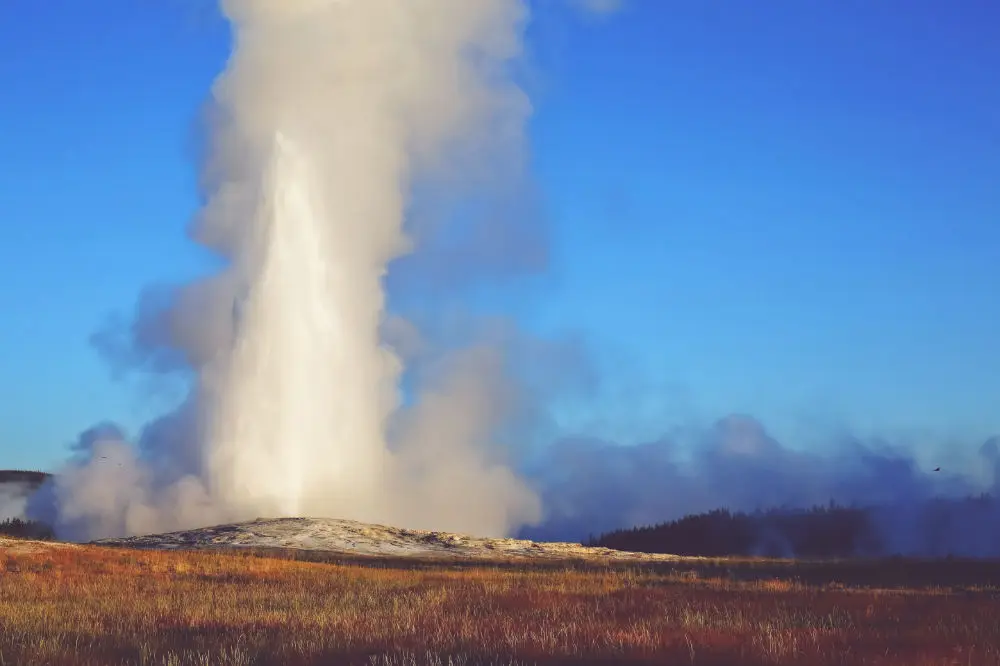
Over the years, The Geysers has undergone significant expansions and technological advancements, maintaining its position as the world's most extensive geothermal complex. These developments have increased its power generation capabilities and highlighted its role as a benchmark for sustainability and innovation within the energy sector.
The complex's success is supported by a commitment to environmental preservation and the adoption of cutting-edge technologies aimed at optimizing resource utilization and minimizing ecological impact. The achievements at The Geysers underscore the vital contribution of geothermal energy to diversifying energy sources and achieving a more sustainable and renewable energy mix.
Looking to the Future: Geothermal Energy's Role in a Renewable World
As the world increasingly shifts its focus towards sustainable and clean energy solutions, geothermal energy emerges as a crucial component in this green revolution.
The Geysers demonstrates geothermal energy's viability on a grand scale and highlights its potential to contribute significantly to a renewable-dominated energy landscape. The ongoing advancements in geothermal technology, driven by the legacy of The Geysers, are setting the stage for more efficient, cost-effective, and environmentally friendly geothermal power plants across the globe.
This progress, coupled with a growing recognition of the need to transition away from fossil fuels, positions geothermal energy as a key player in achieving a sustainable future. By harnessing the Earth's heat with minimal environmental impact, geothermal energy offers a reliable, continuous power source crucial for meeting the increasing global energy demands while combating climate change.
As such, the future of geothermal energy is not just promising; it is indispensable in our journey towards a cleaner, renewable-powered world, where projects like The Geysers serve as both a foundation and inspiration for generations to come.
Also read:
